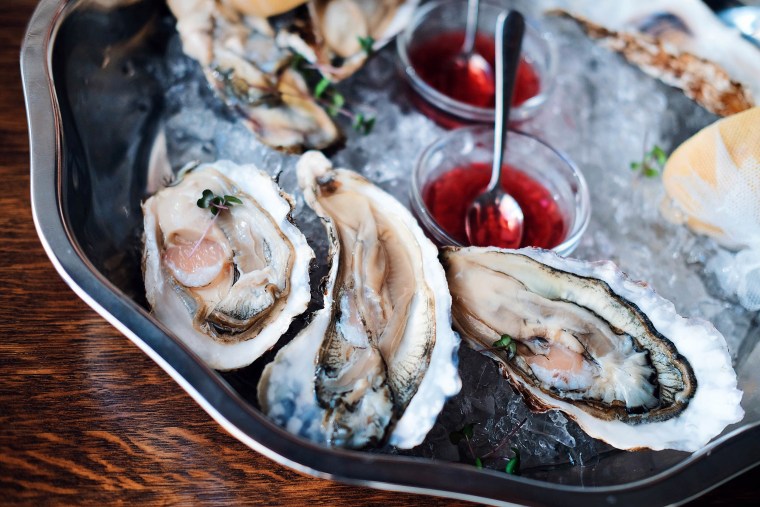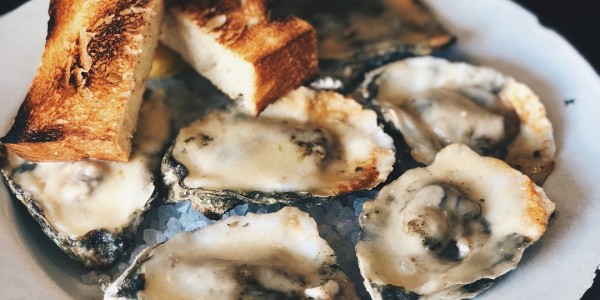With reports of foodborne illness from oysters increasing, and even some recent deaths caused by several species of bacteria called Vibrio vulnificus, a lot of people are wondering whether they’re safe to eat. How can you tell if an oyster is bad?
The first step is to take a peek inside, and fifth generation seafood expert Salvador “Blake” Sunseri says there’s more than one way to shuck an oyster. As operations manager of P&J Oyster Company in New Orleans, Sunseri and P&J’s owners, his father Alfredo and his uncle Salvador, know more about how to separate a bivalve from its valves than anyone. Sunseri says that a chain-mail glove and a thick towel in your oyster-holding hand is a must.
“You can cheat a little bit and set up the shell vertically,” he admits, “and then tap the hinge with a hammer to make it easier to pop the oyster open. Another way is to chip off a little bit of the bill so you can carve the oyster right through the hole.”
Regardless of technique, an FDA spokesperson tells TODAY.com that they advise covering wounds carefully and washing with soap and water after handling any raw seafood, because while most cases of illness occur from eating raw or undercooked shellfish, you can also get sick from contact with cuts or scrapes.
Seafood purveyors like P&J’s will do the shelling for you though, and there are lots of options. Washed oysters have a two-week shelf life and a great flavor, Sunseri says, but for perfect flavor, unwashed oysters packed with their natural liquid have a one-week shelf life as long as they’re kept on ice or in the fridge at 35 F. A few processors offer oysters treated to reduce Vibrio with the FDA-approved processes of pasteurization or high-pressure processing, too.
Once that shell is out of the way, what should you look for? Sunseri notes that you shouldn’t worry about variation in appearance by time of year. In the warm months, they slim down for spawning.
“In summer, they could be a little translucent, kind of like a blister with water in it,” he says. “There’s nothing wrong with them; they’re just skinnier and are going to shrink a lot more when cooked.” He suggests using these for soup or gumbo, where they soak up the seasonings and are the perfect bite size for a spoon.
In the winter, oysters plump up and reach their peak. “You can cook them any which way you want,” says Sunseri, and the flavor can’t be matched. Regardless of the season, though, he says, “if they look dry, you don’t want to eat that oyster.”
Assuming they pass visual inspection, take a whiff. “A good one smells like the ocean,” Sunseri says, but if it’s bad, “It’s going to be like an ammonia smell in extreme cases, or sour — any strong, sharp smell.” If there’s any “off” scent after you shuck it? Chuck it.
Unfortunately, there’s no way to totally eliminate risk even if you follow these tips, because Vibrio is naturally occuring in sea water all year, and everywhere. Says an FDA spokesperson to TODAY.com, “It’s important to note that an oyster that contains Vibrio doesn’t look, smell, or taste any different from other oysters. The only way to kill vibrio in oysters is by cooking them properly. Even hot sauce and lemon juice don’t kill Vibrio bacteria, and neither does alcohol.” They recommend always cooking oysters and other seafood thoroughly to minimize health risks, including death.
Despite that risk, as easy as it may be to separate the oyster from the shell, it’s all but impossible to separate coastal United States cuisine from the oyster. Sunseri’s father Alfredo tells TODAY.com that evidence of oyster-eating goes much farther back than his family’s 150 years in the French Quarter, starting with native people who hand-harvested oysters thousands of years ago, and continuing to New Orleans founder Jean Baptiste Le Moyne de Bienville. “You’d be shocked at the amount that the French harvested here,” he says. The obsession continues to the present day, so what’s a bona fide oyster aficionado to do?
If you’re concerned about illness or are at high risk due to a medical condition, there are plenty of cooked oyster options that manage risk without besmirching their culinary reputation. Steaming or chargrilling allows more control than boiling, which can result in shoe leather on the half-shell. Fried is a good choice, too, or a crispy-edged gratin-style dish like the Sunseri family’s own Oysters Joseph. Oysters can stand up to robust ingredients like Parmesan and hot sauce, so don’t be shy with seasoning.
Listening to the Sunseris talk about oysters and their proud culinary history, you can smell the sea, hear the waves — and that’s what amazing food does: It connects us to our histories, ourselves and our world. Heed your doctor, consider the time of year, season with your heart, and let the good times roll.

